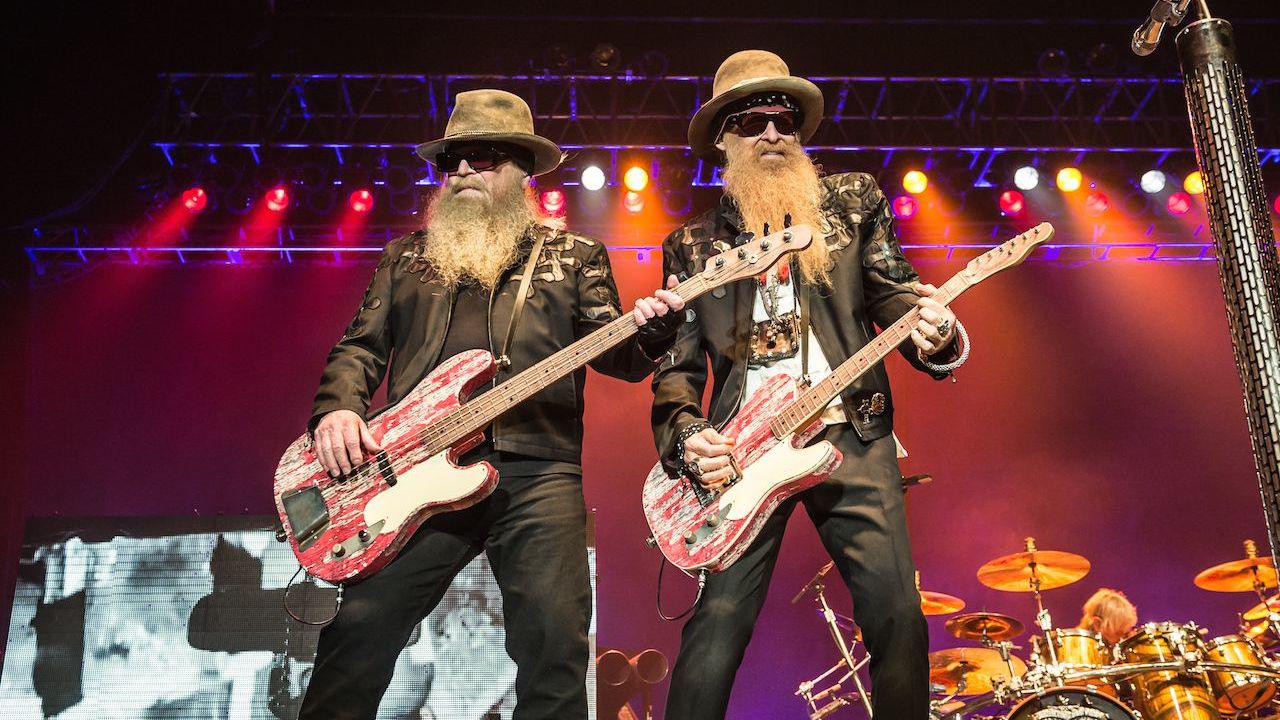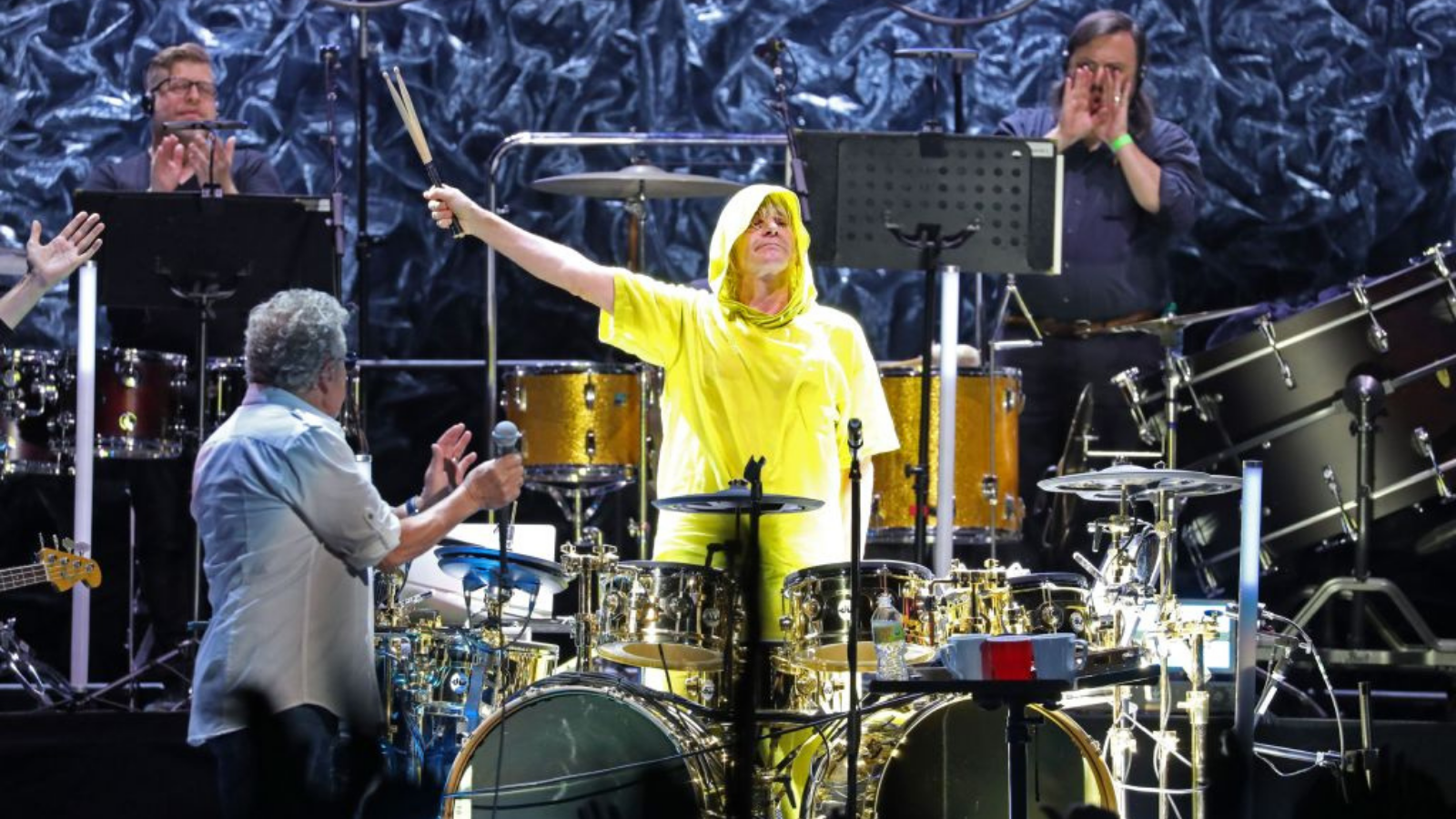Billy Gibbons: Don't Mess With Texas
ZZ Top mainman Billy Gibbons has taken some time off to indulge in his love of Cuban and Latin music with his new band The BFG’s. He tells us of beards, blues and picking up chicks…

Today ZZ Top’s gleaming tour bus is parked up in an especially picturesque spot on the outskirts of the old Colorado mining town of Telluride, population less than three thousand.
Sited at the head of a verdant Rocky Mountains canyon and bordered on three sides by sheer, iron-grey cliff walls, Telluride is evocative of rugged frontiersmen and gold rushes. Tomorrow evening the self-styled ‘little ol’ band from Texas’ will headline Telluride’s annual Blues And Brews Festival, their latest engagement on a three-month-long swing around North America also known as the Grooves & Gravy Tour.
For the past two days, storms and high winds have buffeted the Midwestern heartlands, forcing the trio to cancel a scheduled outdoor show in Boise, Idaho. Gibbons was particularly put out by this, since he was also meant to take delivery of a batch of new guitars from his man in Boise. On this late-summer afternoon, though, the clear mountain air is still and benign, there’s a milky sun high up in the pale blue sky, and Gibbons, a spry 65, is otherwise at peace with the world. He enjoys indulging his passion for travel on the road, and has done so now for going on 50 years as a professional musician.
The son of a concert pianist, Gibbons started out fronting the Moving Sidewalks, a trippy, psychedelic-blues quartet he formed at 18 in his native Houston, Texas and who opened up for both Jimi Hendrix and The Doors. Hendrix was moved to proclaim him America’s greatest living guitarist. Gibbons pitched up next in ZZ Top, debuting the line-up of the band that still endures – with bassist Dusty Hill and drummer Frank Beard – at the Knights Of Columbus Hall in Beaumont, Texas on February 10, 1970. From then until now, they’ve ticked over like a finely tuned engine, fuelled by a rich soup of high-octane boogie and soulful Texan blues, and oiled by Gibbons’s ringing, stinging guitar. As a band they are also, of course, synonymous with chest-length beards, their tongue-in-cheek videos and with each other. Gibbons has guested with everyone from BB King to Queens Of The Stone Age and Al Jourgensen’s Revolting Cocks, but he, Hill and Beard have stuck so close as to appear grafted together.
Late last year, though, Gibbons was invited out to Havana, Cuba to perform – without Hill and Beard – at the city’s well-established jazz festival. In the event, the date proved to be unworkable for him, but it was nonetheless the catalyst for his first solo album. Credited to Billy Gibbons and a four-piece backing band called The BFG’s, and recorded in Houston, Austin, Los Angeles and Spain, the resulting Perfectamundo sounds, rather fetchingly, like a mambo ZZ Top. Introducing Latin American percussion and brass inflections to his more familiar 12-bar gumbo has, it transpires, put a spring in Gibbons’s step.
“Why now?” he muses in his Texan burr, when asked what took him so long to step outside the ZZ Top tent. “Well, that is a good question, and I’m still trying to figure the answer out.”
From the first guitar note on* Got Love If You Want It, *the opening track on Perfectamundo, it couldn’t be anyone but you playing. What does it take to acquire a style that’s quite so distinctive?
Sign up below to get the latest from Classic Rock, plus exclusive special offers, direct to your inbox!
Gee, I was talking about this very thing just the other day and with regard to Ry Cooder. At the present time there’s quite a bit of his material to draw from, which makes him easier to identify. I’m certain, though, that if he were to put out something new tomorrow, you would still know it was Ry Cooder. With a guitar player there’s just something in the hands.
That first song, it sounded so bluesy, and this was supposed to be a jazz record we were making, so I suggested I play something other than the famous old Les Paul. I switched to a Fender but it still came out as the blues. In all we went through five or six different guitars and they all sounded the same. So I guess I’m just stuck with these hands.
How often do you just play for the fun of it?
There’s a lot of spare time when one finds one’s way on to a tour bus. The experience is much more comfortable now, I would say. But the one thing they have not found a way to conquer is how to shorten the length of a mile. Just recently I’ve been making my way back to banging away on a guitar between the so-called points A and B, and it’s been real nice.
When did you last surprise yourself with something you played?
This Perfectamundo thing is still a bit of a surprise to me. It was more of a challenge: “Hey, can you play jazz and make it sound Cuban?” My Spanish is so poor that writing compositions in a foreign language was downright humorous. Musically what we did was lay down the sound of all these Latin percussion instruments – congas, bongos, timbales, maracas – just to get the ball rolling. Then we gave ourselves Spanish nicknames. Mine was Memo, which in any case is the Spanish for Billy.
The version of Baby Please Don’t Go that’s on the record has won great favour with me. We had some visitors come down to the studio to hear the record, and they asked me to play them that song again. I told them they’d heard it a hundred times already, but they wouldn’t believe it and were adamant it was new. I took that as a compliment. We certainly got away with something really off-the-wall there. All in all it’s proven to be a new kind of wrinkle, an odd, strange twist after four decades of doing one thing with ZZ Top.
Have Dusty and Frank heard the album, or are they off sticking pins in a Billy Gibbons doll?
[Laughing] No, they both picked up on it early on. I had to borrow some maracas from Dusty’s collection. He told me that he was kind of getting to like where the project seemed to be going, because if I ended up taking it out on the road he said he would be able to go off on vacation for a change. So I don’t know if each of them is behind it for entirely selfish reasons or not.
After forty-six years of being in a band together, what do you still argue about?
We’ve got this one band in-joke. Every night on stage, we’re all looking at each other to see which of us is going to make the first mistake of the show. That’s pretty much the only thing between us that’s still open to question.
*Picking Up Chicks On Dowling Street* is the most ZZ Top-like song on the album. When exactly did you last do that?
Ha ha! That goes way back. That’s a part of growing up in Houston. Dowling Street was the main drag through Houston’s famous fourth ward, which was the private property of a black impresario on the city’s music scene, a guy named Don Robey. He owned two blues labels, Duke Records and Peacock Records, and a couple of nightclubs on Dowling Street, the most popular of which was the Eldorado Ballroom. Man, if you wanted to have a good time in those days you took your chances and made the corner of Dowling Street.
Your interest in Cuban music also goes back to the sixties, when you studied under the ‘Mambo King’, Tito Puente, in New York?
I was twelve at the time. My dad knew Tito Puente. I could tell you that it was a serious stab at becoming a dextrous percussionist, but the truth is my dad was tired of hearing me banging on the bottom of a metal garbage can. He told me that if I was going to do it, I was going to do it right, and I was packed off to New York. I must have had something on the ball, though. When I arrived, Tito asked me show him what I could do, so I started hitting this and that. He told me: “Okay, you’ve got the feel.” It’s funny, I hadn’t picked up drum sticks and banged on a timbale almost since then, but it came back like riding a bicycle.
What advice would you pass on back to your teenage self if you could?
For starters, there’s the vision of smiles for miles. Muddy Waters and Jimmy Reed both seemed to enjoy what they got to do. They always beamed at the times they were really getting into the groove. And so did I – so do I. If I could pass something back, I would say: “Turn it up!”
You also took two years away from ZZ Top in the mid-seventies to explore Europe. What for you is the essence of travel?
The real bonus is that anyone lucky enough to travel outside of the United States gets to enjoy the flavours of real food. There’s none of these GM foods. Part of the appeal of the European continent is getting to sample all these wonderful flavours. Spain has become a kind of stopping-off point for me. I’ve become good friends with a Spanish gentleman by the name of Nacho Banos, who’s earned a kind of worldly renown on account of a great book he wrote called The Blackguard, which is an incredibly detailed study of the first five years of Fender guitars, and I like to call on him.
What’s your favourite journey?
My lovely sweetheart, Miss Gilligan [Stillwater, his wife since 2005, pictured below with Gibbons], well, her cousin lives in Madrid and was a fashion model back in the fifties. She was married to the Portuguese ambassador to Spain, who’s long-since gone now, but we go visit her every chance we get. She’s quite the lively one and knows Madrid like the back of her hand. It’s beyond novelty. In general, though, I consider getting out and seeing the world an invaluable experience.
Can you go anywhere without being recognised?
No. Not even to a shopping mall. I often talk with Dusty about this and wonder why we stuck ourselves with these chin whiskers.

What was your last great discovery?
We were in North Carolina just recently and had a day off. We had been invited to take a tour of the Vanderbilt mansion,
the Biltmore Estate, which is quite an attraction. Well, we walked the grounds and had the bonus of meeting the great-granddaughter of George Vanderbilt, who built the place back in the 1800s. She gave us the secret tour, showed us the back stairways.
Anyways, afterwards I hopped in a car and drove into the town of Asheville, where I saw something in a store window that I could not quite believe. The last time I heard of someone finding a decent guitar in a pawnshop was a long, long time ago. There was, though, a 1938 National guitar in the window of this particular pawnshop in Asheville. I had the driver pull up on the corner and went in. The owner told me he had got it in a yard sale. It was all banged up, and in his opinion not to be fussed over, but quite the opposite in my book. This thing was loaded with the right kind of stuff – it had the mojo. It didn’t have a case, so ever since it’s been lying about the band bus. You can’t pass it without being drawn to it. Before you know it, three hours have gone by and your hands are hurting.
Famed producer Rick Rubin recorded ZZ Top’s La Futura album in 2012. He once told me that more established artists were harder to motivate because they had too many other interests and not enough to prove. Does he have a point?
He does. Before working together, Rick and I had been hanging out for twenty-five years. I met him through the Red Hot Chili Peppers and at a rave. The dynamic changed when we also became business associates. Making that record was a very serious process. Rick has rarely been credited with maintaining a great level of patience. Frank and Dusty pulled me aside one day and asked how many times we were going to have to play this one particular song. Rick had got us to take, I guess, thirty-five passes at it in four hours. I told them to watch Rick through the glass. He’s not sitting there reading a magazine while you’re performing, he’s waiting for that one special moment that can make or break a song. Sometimes it never comes. He told me he couldn’t even estimate how many ‘almost good’ songs he had sitting on the shelf.
For me and my own musical aspirations, it’s the Texan guitarists who still come up with the mysteries from the unknown. And that goes way back to a couple of my all-time favourites: Lightnin’ Hopkins and Freddie King. Articulating those two stylistic champions is still the bomb.
And what’s the greatest lesson you’ve learned?
Probably BB King’s admonition to play heavy and don’t work too hard – to use light-gauge strings.
If there was just one song of yours that you could preserve for future generations, which would it be?
You can go all the way back to 1973 when we released the *Tres Hombres *record, our first million-seller, and the song La Grange. There’s not a single song on that offering that I don’t like, though. Or coming right on forward, the song* I Gotsta Get Paid* on La Futura is quite something.
When and where are you happiest now, and what would you be doing?
The recording studio and the night lights on stage are both rather comfortable. If Tucson and Santa Fe, New Mexico would float on over into Texas with some Los Angeles-meets-Johannesburg thrown in, that’ll also get the motor rolling. Play some blues on top of all that and you’ve got something to sink your teeth into.
What are you afraid of?
Man, learning that fourth chord.
And when this journey on earth is done, where are you going and what are you taking with you?
You know, we’re all passing through with a job to do. In the meantime I plan to enjoy the novelty of whatever comes my way, and then take the best and leave the rest.
LIGHTS, CAMERA, ACTION!
Some of Billy Gibbons’s silver screen and TV appearances
Back To The Future Part III
It wasn’t much of a stretch for Gibbons to portray a Wild West musician in the (rubbish) third installment of the time-travelling yarn. “Of course, they didn’t need any kind of make-up to appear in the old West,” producer/screenwriter Bob Gale remembers of the Top’s cameo in the hoedown scene. “In-between takes they would just start jamming with the local musicians who were playing the fiddles and all the other stuff.”
Two And A Half Men
In the 2010 episode Gumby With A Pokey, Gibbons and co. turn up in the living room of a hallucinating Charlie Harper (Charlie Sheen) and perform their trademark arm-swing. “This isn’t happening…” mutters a befuddled Harper.
Bones
Gibbons’s recurring role as the terrifyingly protective father of Angela Montenegro remains shrouded in mystery. “We never really say who he is,” says series creator Hart Hanson. “We never identify him. He just appears. He’s playing himself, but he’s playing a different version of himself. He’s a better actor than people give him credit for.”
(Trivia: Angela Montenegro’s middle name is Pearly Gates, the same name as one of Gibbons’s Les Paul guitars.)
CSI: Miami
By appearing in the 2010 episode L.A. – directed by Rob Zombie, no less – Gibbons lost any remaining hope of being able to go anywhere incognito. “With all that exposure,” he told our sister title The Blues Magazine, “I can’t go ten blocks without someone saying, ‘Hey, what’s going on, man?’”
Paul Rees been a professional writer and journalist for more than 20 years. He was Editor-in-Chief of the music magazines Q and Kerrang! for a total of 13 years and during that period interviewed everyone from Sir Paul McCartney, Madonna and Bruce Springsteen to Noel Gallagher, Adele and Take That. His work has also been published in the Sunday Times, the Telegraph, the Independent, the Evening Standard, the Sunday Express, Classic Rock, Outdoor Fitness, When Saturday Comes and a range of international periodicals.

